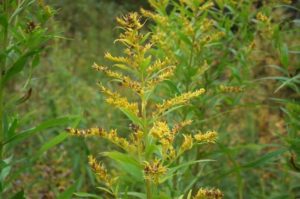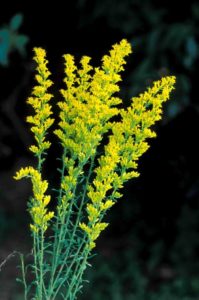Goldenrod
Scientific Name: Solidago spp.

Where to start with Goldenrod! Have you tried pronouncing its scientific name yet? Sol-i-da-go! Is it just me, or does saying that out loud kind of bring western name vibes? Like I just imagine Clint Eastwood would have a friend named Solidago and they would just go be two bad asses together! Okay okay, back to the business. Solidago is in reference to “making things whole“. Goldenrod has a way of doing this giving spotlight to the fact it is known for its vulnerary properties– or wound healing abilities!
So some juicy facts about Goldenrod off the top is it is both medicinal and a tasty beverage tea! Another cool fact is that Goldenrod is used to make hair dye or fabric dye with its bright mustard yellow flowers. It is also a beneficial companion plant in the garden while it attracts native insects, including many species of bees!
Most species of Goldenrod can be found in North America in plains and meadows and fields. It’s pretty hard to identify when its not in flower as the vegetative part is pretty much non descript. In general, Goldenrods are herbaceous perennials as they die back from the ground in the winter and emerge again in the spring! And re-emerge again the fall.

Both the leaves and the flowers are good to use for medicine! I like to harvest a bunch then bundle them up, and hang them upside down to dry for a few days. Any Goldenrod species can be used medicinally, and identification to the species level is not essential-this is welcome news, as they readily hybridize and are generally considered difficult to identify to species. Goldenrod taste different from species to species though, but what’s important is to know you at least have a Goldenrod species! Some will taste more astringent, and some specialize in resinous flavors. The varieties that are more astringent tend to be more productive for slowing or stopping diarrhea, for stopping bleeding, leaky gut, and for helping inflammation in the GI. Some of the goldenrod species have more of a resiny flavor that’s more desired for tea. Crush a goldenrod leaf when the plant is in bloom to familiarize yourself with its unique aroma. I detect hints of resin in the fragrance in the species that grow near me.
It is important to note that goldenrod looks similar to other yellow flowers that are deadly toxic like Grounsels, Ragworts, Staggerweed, and Life Root. This is a large group of flowering plants and some belonging also to the plant family Asteraceae, to be aware of.
The optimal time to harvest the flowers are when the flowers are just opening up, that’s when the medicine will be more potent. If you wait too long, the mature flowers will turn to brown seed heads after you harvest them and then you’ll end up with a mess everywhere as they easily fall apart at that point.

Goldenrod prime for picking for medicine.
Goldenrod’s Herbal Actions: Diuretic, Anticatarrhal, Antimicrobial, Vulnerary, Astringent, Anti-inflammatory, Diaphoretic, Carminative
Goldenrod is super helpful for sinuses, allergies and congestion. Goldenrod is also a favorite for the urinary tract as it is a powerful diuretic, which means its helpful to flush out bacteria particularly for the urinary tract.
Medicinal Uses: We can contribute what we know about goldenrod’s medicinal uses from Native Americans who traditionally employed various species of goldenrod for a number of ailments, both topically and internally. Goldenrod is an important dermatological aid for sores, infections, toothache, burns and wounds. Internally, like we mentioned above, it is used for a number of urinary, respiratory and digestive ailments. The medicinal use by over a dozen Native groups for close to twenty species of goldenrod has been documented. I also find it interesting that many tribes use the root medicinally-a use not shared by most contemporary Western herbalists.
Although any species of goldenrod can be employed medicinally, aroma, taste and herbal actions will vary from species to species. The overarching uses are similar, but it’s up to you to discover their individual nuances and develop a personal relationship with the species you grow or forage.
Goldenrod is a premier decongestant, effectively alleviating upper respiratory complaints that result from allergies, sinusitis, flu or the common cold. It can be produced and taken as a tea, syrup, or tincture for this purpose. In my experience, it is one of the strongest herbs for drying the sinuses. Also cool to note that you can gargle goldenrod tea that can be used for sore throats, thrush, and laryngitis!
Goldenrod also has a special affinity for the urinary tract because of its diuretic, anti-microbial and anti-inflammatory properties to treat infections of the urinary tract. The diuretic quality of goldenrod is also helpful in treating edema, gout and kidney stones.
If you’re looking for a comprehensive guide to identify plants and even collect your leaves as a keepsake, check out our foraging journal! It’s great for beginners and moderate wildcrafters alike!
Precautions and Contraindications: Goldenrod can be overly drying as a beverage or tonic tea for people with a dry constitution, as it is diuretic, astringent, and decongestant. Short-term usage shouldn’t be a problem. Do not use in pregnancy. Although rare, goldenrod has caused allergic contact dermatitis after both handling and oral administration. Those with Asteracea allergies should exercise caution with goldenrod. Be sure you are harvesting a true Solidago species because there are deadly look-alikes.
Hope you enjoyed this article on Goldenrod and let us know over on instagram @seed_and_sparrow if you use it or grow it!
Studies that include Goldenrod (Solidago spp.) found here!
